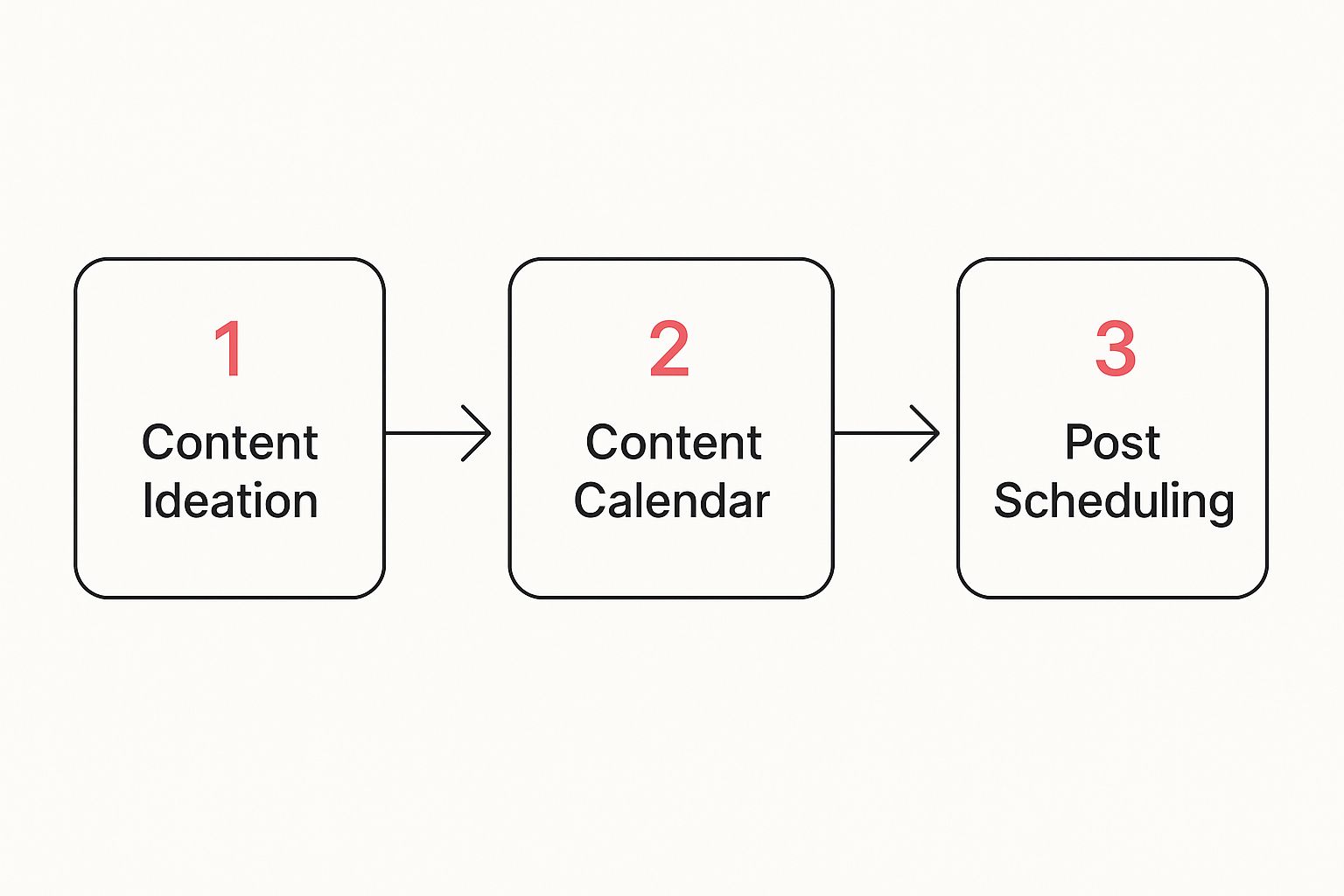Social Media Management for Your Business: The Ultimate Guide
So, what exactly is business social media management?
In a nutshell, it’s the strategic process of creating, scheduling, analysing, and engaging with everything you post on your social media platforms. But it’s so much more than just throwing up a few updates here and there. It’s a complete approach to shaping how your brand shows up online, building real relationships with your audience, and, crucially, driving tangible business results.
Defining Social Media Management for Your Business
Think of it like this: you’re the host of your brand’s ongoing digital party. A common mistake is thinking that just having a profile on a few platforms is enough. That's like booking a venue and then leaving the doors locked. Proper management turns those channels from a static noticeboard into a powerful engine for building brand loyalty, generating leads, and fuelling real-world growth.
The whole process is about a deliberate set of actions that bring your brand's voice to life. You're crafting the right atmosphere with your content, inviting the right guests (your target audience), sparking brilliant conversations, and making sure everyone feels heard. It’s a dynamic, two-way street, not a monologue.
The Core Pillars of Social Media Management
Great social media management isn’t a single activity; it's a combination of several essential parts working together. Getting these pillars right is what creates a strong, consistent online presence that actually connects with customers and hits your business goals. If you neglect one, the whole structure starts to wobble.
This table breaks down the non-negotiables.
| Pillar | What It Means | Why It Matters |
|---|---|---|
| Strategic Planning | Setting clear goals tied to your business objectives, pinpointing your target audience, and choosing the platforms where they actually spend their time. | Without a plan, you're just posting into the void. Strategy gives your efforts direction and purpose, ensuring every action has a reason behind it. |
| Content Creation & Curation | Developing and sharing valuable, relevant, and consistent content—from original videos and articles to interesting finds from elsewhere—that speaks directly to your audience. | This is what keeps people coming back. Great content builds trust, establishes authority, and gives your audience a reason to follow and engage with you. |
| Community Engagement | Actively monitoring and responding to comments, messages, and mentions. This is where you talk with your audience, not just at them. | Engagement is where relationships are built. It fosters loyalty, helps manage your brand’s reputation, and turns passive followers into active fans. |
| Analytics & Reporting | Tracking key metrics to understand what’s working and what isn’t. This means digging into the data to see what content resonates and drives action. | Data tells you the truth. Analytics allow you to stop guessing and start making informed decisions to refine your strategy for better results over time. |
Each of these pillars supports the others. You cannot have great engagement without great content, and you will not know what great content is without solid analytics.
Moving Beyond Simple Posting
The ultimate goal here is to weave social media into the very fabric of your business. It is not just a marketing function siloed away in a corner. To see how a specific platform can be integrated into a wider business strategy, this guide on how to use Pinterest for business is a brilliant example. It shows how a visual first platform can be used for specific goals like driving ecommerce sales or blog traffic.
Social media management is not just a marketing task; it is a vital business operation that influences customer service, sales, and brand perception. It requires a blend of creativity, strategic thinking, and analytical skill to turn followers into loyal customers.
In the UK's crowded market, treating social media as a core part of your business is not just a good idea—it is essential for survival and growth.
Why Your Business Needs a Social Media Strategy
Let us be blunt. A social media strategy is not about racking up followers or likes; it is about building real, tangible value that hits your bottom line. Without a clear plan, you are just shouting into the void and hoping someone listens. A strategic approach, however, turns your social channels into powerful, hardworking assets for growth.
Investing in proper social media management for business is the difference between random acts of posting and deliberate, results-driven action. It is the contrast between a shopkeeper randomly yelling offers into the street versus one who knows their customers, builds genuine relationships, and creates an atmosphere that keeps people coming back.
This is not just a fleeting trend—it is a core part of modern business. The UK market for social media management services is exploding, with a predicted compound annual growth rate (CAGR) of 21.8% from 2025 to 2030. By 2030, the sector is expected to be worth around $5,246.2 million . This rapid growth, highlighted in reports from places like Grand View Research , shows just how vital social media has become for any business that wants to stay relevant.

Cultivate Genuine Brand Credibility
In today's world, credibility is built on consistency and authenticity. A scattered, here today gone tomorrow posting schedule makes your business look unreliable. In contrast, a well managed strategy delivers a steady stream of valuable, professional content that builds trust, one post at a time.
Think of a local financial adviser. If their LinkedIn profile is a ghost town, would you trust them with your money? Probably not. But if they consistently share smart takes on market trends and answer questions with real expertise, they establish themselves as an authority. That effort turns their profile into a signal of trustworthiness.
A strong social media strategy is your brand's digital handshake. It conveys professionalism, builds trust, and makes the first impression long before a customer ever speaks to you directly.
This consistent presence shows you are an active, engaged business that takes your industry—and your audience—seriously. Over time, that reliability makes you the go to source, nurturing a reputation that generic advertising just cannot buy.
Generate Higher Quality Leads
Let us be clear: not all leads are created equal. A strategic approach to social media helps you attract people who are genuinely interested in what you offer, rather than just casting a wide, ineffective net. When you create content that speaks directly to your ideal customer’s problems, you cut through the noise and connect with a far more qualified audience.
For example, a boutique software firm could use targeted articles on LinkedIn to address specific challenges that project managers face. This does more than just get clicks; it attracts professionals who are actively looking for the very solution you provide.
- Solve Problems Directly: Create content that answers the questions your ideal customers are already asking.
- Target Precisely: Use the powerful tools on each platform to zero in on specific demographics, job titles, or interests.
- Showcase Success: Share case studies and testimonials that prove your value in the real world.
This approach brings in leads who are already warmed up to your brand. They already get what you do, which makes the sales process a whole lot smoother.
Open a Direct Line for Customer Service
Social media has quickly become a frontline for customer support. When people have a question or an issue, their first stop is often platforms like X (formerly Twitter) or Facebook for a quick response. An active, responsive social media presence gives you a golden opportunity to deliver outstanding service where everyone can see it.
Imagine a customer has an issue with a product they bought from your ecommerce store. A swift, helpful reply on social media does not just solve their problem. It shows every single person who sees that interaction that you genuinely care. It turns a potential negative into a public demonstration of your commitment, building loyalty and reassuring anyone who might be thinking of buying from you.
Building Your Social Media Management Strategy
A killer social media presence does not just happen. It is built, piece by piece, with a deliberate and well thought out strategy. Without a plan, you are just posting into the void, making it impossible to know what is actually moving the needle. This is where you draw the blueprint for your entire social media operation.
Think of it like building a house. You would not start laying bricks without architectural plans, a clear idea of who is going to live there, and a good look at the neighbouring properties. The same logic applies to effective social media management for business —strategy always comes first.
Setting SMART Goals for Social Media
Every single thing you do on social media should tie back to a concrete business outcome. Vague hopes like "get more followers" or "boost engagement" are not goals; they are wishes. To give your strategy teeth, you need to set SMART goals .
This simple framework makes sure your objectives are clear, focused, and actually reachable.
- Specific: Nail down exactly what you want to achieve. Instead of "more website traffic," aim for "increase blog traffic from LinkedIn by 20% ."
- Measurable: Use real numbers to track your progress. How will you know you have won? This could be lead form completions, click through rates, or follower growth.
- Achievable: Be ambitious but realistic. Your goals should stretch you, but not be so far out of reach that you are set up to fail with the resources you have.
- Relevant: Does this goal actually matter to the bigger picture? Does driving more traffic from LinkedIn really support your overall sales targets?
- Time-bound: Give yourself a deadline. A goal to "increase traffic by 20% in the next quarter" creates a sense of urgency and a clear timeline for checking in.
Setting SMART goals turns your social media from a passive, time filling activity into a focused, results-driven part of your business. It gives you the clarity you need to make smart decisions and prove the value of your work.
Understanding Your Target Audience
You cannot create content that hits the mark if you have no idea who you are talking to. A deep, almost obsessive understanding of your target audience is the bedrock of any winning strategy. You need to go way beyond basic demographics and build out detailed audience personas .
An audience persona is essentially a character sketch of your ideal customer. It helps you step into their shoes and see the digital world from their point of view.
To truly connect with your audience, you must understand their challenges, motivations, and digital habits. The goal is to answer the question, 'What problems can my business solve for them?' and create content that provides that solution.
To start building your personas, ask yourself these crucial questions:
- What are their biggest professional or personal headaches?
- Where do they actually spend their time online? Are they scrolling Instagram, reading long form articles on LinkedIn, or watching tutorials on YouTube?
- What kind of content do they find genuinely valuable—is it educational, entertaining, or inspirational?
- What tone of voice will they respond to? Should it be professional and authoritative, or casual and witty?
Once you have these personas fleshed out, every single piece of content you create should be crafted with one of them in mind. This is how you ensure your message is always relevant and speaks directly to the people you want to reach.
Conducting a Competitor Analysis
You are not operating in a bubble. Your competitors are all fighting for your audience's attention, and keeping a close eye on their activity can uncover some absolute gold. A competitor analysis helps you understand the lay of the land, spot gaps in the market, and figure out your unique angle.
This is not about copying what everyone else is doing. It is about learning from their wins and their mistakes to make your own approach even sharper.
- Identify Key Competitors: Make a shortlist of three to five direct competitors who are active on social media.
- Analyse Their Presence: Dig into which platforms they use, how often they post, and the kind of content they are putting out there.
- Evaluate Engagement: Look at their metrics. Which posts are getting the most likes, comments, and shares? This is a massive clue as to what your shared audience cares about.
- Pinpoint Strengths and Weaknesses: What are they nailing? And where are they dropping the ball? Maybe their visual branding is slick, but their community management is non-existent. That is your opening.
This analysis helps you find opportunities to be different. If all your competitors are buttoned up and formal, maybe a more conversational and authentic voice will make you stand out. The insights you gather here are vital for shaping your content and carving out your own space. For a more comprehensive look at developing robust social media plans, delve into these expert social media marketing strategies which offer deeper guidance. Should this process feel overwhelming, remember that many businesses find immense value in exploring https://www.superhub.biz/the-benefits-of-having-a-social-media-management-agency handle these complexities.
This infographic shows a typical workflow for turning strategic ideas into scheduled content.

This process visualises how a consistent strategy moves from initial ideas to a structured calendar, ensuring your execution remains organised and aligned with your goals.
Choosing the Right Social Media Platforms

Spreading your efforts thinly across every social media platform is a classic mistake. It’s the digital equivalent of trying to be in ten places at once; you end up making no real impact anywhere. A much smarter approach is to pick your channels with surgical precision, focusing your resources where they will actually move the needle.
Effective social media management for business is not about being everywhere; it is about being in the right places. Every platform is its own little world, with distinct user demographics, content styles, and unwritten rules. Get a feel for these nuances, and you will avoid wasting a serious amount of time and money.
The goal is to match your chosen platforms to your specific business goals and, most importantly, your audience. A B2B consultancy aiming to build authority would be far better off investing time in LinkedIn than on TikTok. On the flip side, a craft brewery would find Instagram’s visual first vibe a much more natural fit for showing off its brand and products.
Which Social Media Platform Is Best for Your UK Business?
To make the right call, you need to understand the landscape. This means looking past raw follower counts and digging into who uses each platform and why they are there. With the UK social media ad market projected to hit a staggering £9.95 billion in 2025 and 79% of the population active on social media, picking the right channel is critical for reaching your slice of the market. For a deeper dive, Sprout Social's research offers some fantastic insights into the UK scene.
This table breaks down the main players to help you decide where to focus your energy.
| Platform | Ideal for Reaching | Best Suited For | Top Content Formats |
|---|---|---|---|
| A broad age range (25-55+), local communities, and interest based groups. | Community building, local business marketing, targeted advertising, and customer service. | Live video, user generated content, event promotion, and curated links. | |
| Millennials & Gen Z (18-34), visually driven consumers. | Ecommerce, fashion, food & beverage, travel, and lifestyle brands. | High quality images, Reels (short form video), Stories, and influencer collaborations. | |
| X (Twitter) | Journalists, industry leaders, and highly engaged, real time users. | Breaking news, customer support, real time event coverage, and brand personality. | Quick updates, polls, threads, GIFs, and links to blog posts or news. |
| B2B professionals, decision makers, and job seekers. | B2B lead generation, professional networking, employer branding, and thought leadership. | Articles, case studies, company news, professional videos, and text based posts. | |
| TikTok | Primarily Gen Z and younger Millennials (16-24). | Brands wanting to show a creative, authentic, and entertaining side. | Short form videos, tutorials, behind the scenes content, and user challenges. |
Remember, this is a starting point. The best strategy often involves a primary platform where you invest most of your effort, supported by one or two secondary channels for specific purposes.
Matching Your Business to the Platform
Let us connect this to the real world. The right choice hinges entirely on your goals and who you are trying to talk to.
Choosing a social media platform is like picking a location for a shop. You would not open a high end jewellers in the middle of a skate park. You need to go where your ideal customers already are and, crucially, where they are in the right mindset to hear from you.
Think about what your business actually does. Are you selling a physical product, a professional service, or building a community? The answer will point you toward your ideal platform mix.
Strategic Platform Selection in Action
Consider these examples:
- A Local Estate Agent: Their focus should be squarely on Facebook and Instagram . They can use Facebook to target local postcodes with new listings and community updates. On Instagram, high quality photos and video tours (Reels) can build an aspirational brand and showcase beautiful homes.
- A B2B Tech Consultancy: Their prime real estate is LinkedIn . This is where they publish insightful articles, share client case studies, and engage in professional groups to prove their expertise. X can work well as a secondary platform for sharing quick takes and joining industry chatter.
- A Fashion Ecommerce Brand: Instagram and TikTok are non-negotiable. Instagram is perfect for curated product shots and shoppable posts. TikTok offers a massive opportunity to go viral with creative "outfit of the day" videos, behind the scenes content, and fun user challenges.
By making these strategic choices, you concentrate your energy, create content that truly connects, and ultimately get a much better return on your investment.
The Day to Day of Social Media Management

A brilliant social media strategy is just the starting line. Bringing it to life is a daily grind, a consistent effort where the plan hits the pavement. This is the operational side of social media management—a dynamic blend of creativity, customer service, and sharp planning that keeps your brand’s online pulse strong and steady.
This is not about posting on a whim. The day to day work is a structured routine, a set of deliberate actions all designed to build your community and smash your business goals. Let us pop the bonnet and look at the core tasks that really move the needle.
Content Creation and Curation
Content is the fuel for your entire social media engine. A massive chunk of the daily routine is dedicated to crafting original, valuable posts that actually connect with your audience. This could mean writing a genuinely helpful tip, designing a graphic that stops the scroll, or editing a quick video that shows off your brand’s real personality.
But it is not all about you. Content curation —finding and sharing relevant articles, news, and insights from other respected sources—is just as crucial. It positions your brand as a go to resource in your industry, not just a company that only talks about itself.
Effective social media management is a balancing act between creation and curation. It’s about being an interesting voice in the conversation, not just shouting about yourself. This is how you build real trust and keep your audience coming back for more.
This dual approach keeps your content calendar fresh, varied, and genuinely interesting.
Community Engagement and Nurturing
This is the absolute heartbeat of social media. It’s the process of actively listening, talking, and interacting with your audience, turning your channels from a simple broadcast tool into a thriving community hub. The daily tasks here go way beyond a quick glance at your notifications.
Real engagement looks like this:
- Responding Promptly: Acknowledging comments, answering questions, and handling feedback with speed and authenticity.
- Nurturing Conversations: Going deeper by asking follow up questions, encouraging discussion, and making your followers feel genuinely heard.
- Managing Direct Messages: Treating private enquiries with the same level of care as public comments, often becoming a vital customer service channel.
It is this consistent, two-way interaction that turns passive followers into loyal brand advocates.
Smart Scheduling and Social Listening
To maintain a constant presence without being chained to your screen 24/7 , smart scheduling is non-negotiable. Using management tools to plan and automate your posts means you can batch create content, guaranteeing a steady flow of updates at the best possible times. Tools like Buffer or Hootsuite are indispensable here, freeing you up to focus on engagement instead of manually hitting 'post'. The cost of these tools is a key factor, and our social media management pricing guide can help you plan your budget.
At the same time, social listening is the critical task running in the background. This is about monitoring conversations—not just about your brand, but about your entire industry and your competitors. It helps you spot trends as they emerge, understand customer frustrations, and find natural opportunities to join important conversations, keeping your strategy sharp and relevant.
How to Measure Your Social Media Success
Are your social media efforts actually making a difference? If you are not tracking your performance, you are flying blind. It is that simple.
Effective measurement is what separates professional social media management for business from just posting and hoping. It’s the bridge between your day to day activity and genuine, tangible business results. This is not about chasing vanity metrics; it is about understanding what truly connects with your audience and how that connection impacts your bottom line.
Key Metrics That Truly Matter
To get a clear picture, it helps to break your metrics down into three core areas. Each one tells a different part of the story, from how many eyeballs see your content to how many people actually take action.
- Awareness Metrics: This is all about visibility. Think of reach (the number of unique people who see your post) and impressions (the total number of times your post was shown). It tells you how far your message is travelling.
- Engagement Metrics: This is where you measure the reaction. We are talking about likes , comments , shares , and saves . These show that your content is not just being seen, it is sparking a response and making people stop scrolling.
- Conversion Metrics: Here’s where your social media work connects directly to your business goals. Metrics like click-through rate (CTR) , website traffic, and lead generation prove that your audience is taking the next step you want them to take.
Digging into these numbers helps you figure out what is working and what is not. For instance, getting a better handle on platform algorithms can have a massive impact on your visibility. You can learn more by mastering social media algorithms in our detailed guide , which can help you create content that platforms naturally want to push out.
Using Analytics Tools to Track Performance
You do not need a degree in data science to start measuring your success. Honestly, you can get started right now, for free.
Most social media platforms have powerful, built in analytics dashboards. Facebook’s Meta Business Suite and Instagram Insights, for example, give you detailed breakdowns of post performance, who your audience is, and when they are most active. These native tools are the perfect starting point for any business.
The goal of measurement is not just to collect data, but to gain insights. By regularly reviewing your analytics, you can stop guessing what your audience wants and start making informed decisions that consistently improve your results.
As your strategy matures, you might want to look at dedicated social media management tools like Hootsuite or Buffer. These platforms pull all your analytics from different channels into one place, offering more advanced reporting and even letting you see what your competitors are up to. It gives you a single, unified view of your entire online presence.
By focusing on these key metrics and using the right tools, you can turn your social media from a hopeful shot in the dark into a predictable, results-driven part of your business. This data backed approach is how you prove your return on investment (ROI) and continuously sharpen your strategy for even bigger wins.
Got Questions About Social Media Management? We Have Got Answers.
It is completely normal to have questions when you are wading into the world of social media for your business. We get it. To make things clearer, here are some straightforward answers to the questions we hear most often.
How Much Time Should I Really Be Spending on This Each Day?
This is the big one, and the honest answer is: it varies. But for a small business just finding its feet, a good benchmark is around one to two hours a day .
That time is not just for posting. It’s for crafting content, scheduling it, jumping into conversations, replying to DMs, and taking a quick look at what’s working. As your audience grows, so will this time commitment. The real key is not volume; it is consistency. One solid, focused hour every single day will beat a frantic eight hour session once a week, every time.
Should I Do It Myself or Hire Someone?
This is a classic 'time vs. money' dilemma, and it really comes down to your resources and your know-how.
- Doing It Yourself: This is the perfect route if you are just starting out, working with a tight budget, and you have got the time and energy to learn the ropes. Nobody knows your brand's voice like you do, and that authenticity is priceless.
- Hiring an Agency or Freelancer: This makes sense when you are short on time or when you need specialist skills like ad management or deep dive analytics. Think of it as a strategic investment once social media becomes a real engine for your business growth.
What is the Real Cost of Professional Management?
The investment in professional social media management for business in the UK can vary wildly depending on what you actually need. Basic services—think caption writing and scheduling posts—often start between £300 and £800 per month .
If you are looking for a more complete service with things like branded photography and consistent content creation, you should budget for something in the region of £1,000 to £1,500 monthly . For bigger, more complex campaigns, that figure will climb. You can get a more detailed breakdown of social media management pricing for 2025 to see what is included at each level.
Too many businesses see social media management as a cost. It’s not. It’s an investment. The right strategy doesn't just chase followers; it builds relationships that generate leads, drive sales, and create loyal customers who come back again and again.
What are the Best Tools for a Beginner?
You do not need a massive, expensive tech stack to get started. In fact, some of the most successful accounts are run on a handful of smart, simple tools.
Start with platforms that offer great free or low cost plans to nail the basics:
- Scheduling: Buffer and Later are brilliant for planning your content visually and getting posts lined up in advance.
- Design: Canva is a game changer. It makes it easy to create graphics that look sharp and professional, even if you have zero design experience.
- Analytics: Don’t overcomplicate it. The built in analytics on each platform (like Meta Business Suite) are more than enough to show you what your audience loves.
These tools give you a solid foundation to build on, without drowning you in features you do not need yet.
Ready to stop guessing and start growing? The expert team at Superhub crafts bespoke social media strategies that deliver real results. Let's build your brand's presence together.





